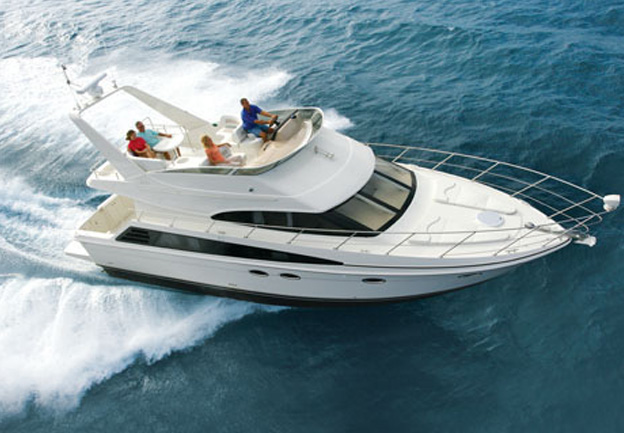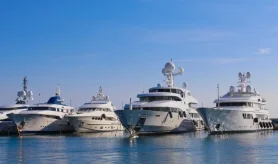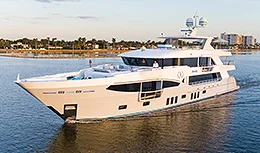- Alaskan Yachts
- Azimut Yachts
- Back Cove Yachts
- Beneteau Yachts
- Benetti Superyachts
- Bertram Yachts
- Boston Whaler
- Broward Yachts
- Buddy Davis Sportfish
- Burger Yachts
- Cabo Yachts
- Catamarans
- Carver Motoryachts
- Center Console
- Chris-Craft Yachts
- Cruisers Yachts
- DeFever Trawlers
- Dufour Sailboats
- Fairline Yachts
- Feadship Yachts
- Ferretti Yachts
- Filippetti Yachts
- Formula Yachts
- Fountaine Pajot Cats
- Grady-White
- Grand Banks Trawlers
- Hargrave Yachts
- Hatteras Yachts
- Hinckley Picnic Boats
- Horizon Yachts
- Hydra-Sports
- Intrepid Boats
- Jarrett Bay Sportfish
- Jeanneau Yachts
- Kadey-Krogen Trawlers
- Lazzara Yachts
- Lekker Boats
- Luhrs Sportfish
- Marlow Yachts
- Maritimo Yachts
- Marquis Yachts
- Mazu Yachts
- McKinna Motoryachts
- Meridian Yachts
- Midnight Express
- MJM Yachts
- Mochi Craft
- Neptunus Motoryachts
- Nordhavn Trawlers
- Nordic Tugs
- Numarine Yachts
- Ocean Alexander Yachts
- Ocean King
- Offshore Yachts
- Outer Reef
- Oyster Sailing Yachts
- Pacific Mariner Yachts
- Palmer Johnson Yachts
Boat Review: 42 Carver Super Sport
Boat Review: 42 Carver Super Sport

Source: Boatpoint.com.au
Fast and smooth in rough water, the Carver 42 Super Sport is a sea savvy vessel in which to make your weekend escape. What’s more, docking is something you’d trust the kids to do, thanks to the fitted Volvo IPS
It was gusting at least 20kts, with a bitter winter wind scurrying across the bay and shunting Carver’s high-volume 42 Super Sport into the fuel wharf during the test of this boat.
Ordinarily, the escape would necessitate plenty of opposing throttle and pivoting off a fender. Or driving forward on a long springer and throwing the rope once you’re a sufficiently safe distance off the marina. Skills stuff.
Of course, many boats have bow and, increasingly, stern thrusters these days. But in strong broadside winds the average 24V bow and stern thrusters are actually pretty useless. Especially when the wind is abeam and the boat is a high volume one.
Volvo IPS Joystick to the rescue!
Fitted with a pair of 370hp IPS 500 motors with forward-facing propellers that swivel in response to the wheel or the latest IPS Joystick control, the Carver decamped from the marina as adeptly as a crab scuttling sideways in a crevice.
In fact, such was the ease with which the boat was shunted off the berth that its local agent, James Mark Anthony from Pathfinder Marine, was moved to make two predictions. First, that women will be doing the docking while the blokes tend the lines. And second, given their predisposition for computer games with joysticks, that kids will be right at home commanding big cruisers. Move over, dads.
The Carver 42 Super Sport with a Euro-style extended flybridge was an interesting boat for other reasons, too. The world’s biggest builder of motoryachts when defined as aft-cabin cruisers and suchlike, Carver employs 1200 people to produce more than 20 models from the 35SS to the 86ft Marquis, with prices ranging from $400,000 to $10 million.
Pathfinder Marine in Sydney, now with outlets in Queensland and Victoria, has been the local agent for more than 20 years. Back in the 1980s, the Carver range went from 21 to 42ft. So you can see the trend to bigger boats and, as with this commodious 42 Super Sport fitted with Volvo Penta’s IPS and Joystick, to bigger and more user-friendly cruisers with all the mod cons.
Hugely popular in the lake regions of America, Carver is actually the most profitable of all the Genmar boat brands today, I’m told. Which is interesting when you consider the different thinking that has gone into these boats and, shall I say, the challenging design lines.
However, once aboard the 42 Super Sport the intentions are clear: two cabins and two heads make for a savvy boat in which to escape with another cruising couple. Thus, this could be seen as a kid-free boat for cruising in adult company. And should the (grand) kids want to camp over, no worries, there’s always the sofa bed in the saloon.
ON-WATER SLEEPING
Considering Carvers are very much high-volume cruisers, where better to start than indoors? I swanned inside the single-level saloon/galley and headed forward to the master cabin in the bow, where I found the mandatory island double bed, dressed with a lovely black and white checked spread, which looked doubly smart surrounded by American cherrywood joinery. Air-con could be called on for ventilation, or you could just open the circular escape hatch for fresh air. But I couldn’t find a pullout shade screen over that ceiling hatch, so you might have to have something cut to fit. However, there were curtains over the fixed port lights.
A mirror on the bedhead added to the sense of space, as did abundant storage in side lockers, under-bed drawers and cupboards and a cedar-lined hanging locker. If you’re looking for the television, it folds flat into a recess in the ceiling liner and there are also speakers for piped music.
Carver makes the most of the volume up front with a split ensuite featuring a moulded WC compartment with sink and Vacu flush loo, and yet more storage space, to starboard, and separate shower stall to port. There was a curtain, moulded seat and opening hatch but no extractor fan in that shower recess. How do you dry it out when it’s raining or you’re underway?
A sliding door on track separates the master suit from the companionway, off which is the VIP guest’s cabin to starboard. You step down to the carpeted floor before a queen-sized double berth, which is flanked by twin opening ports, with head room at the foot of the bed before a hanging locker and drawers.
Across the companionway is the guest’s/day head and a roomy moulded space it is, too. There is a sliding circular shower screen, Vacu flush loo, solid vanity surface, nice spread of bathroom fittings and, yes, an extractor fan and hatch. By my reckoning this is the preferred onboard shower for owners when they’re boating alone.
ON-WATER LIVING
The split high/low windows, which are a product of the boat’s walk around decks, direct lots of light into the single-level saloon. Immediately inside the big glass door to the cockpit is a lounge room of sorts, with a two-person lounge/sofa or bed to port, two swivel tub chairs and a 20-inch television/DVD/sound system opposite, and the AC/DC panel with incremental water and waste-tank gauges nearby.
Check to see if you can empty the holding tank with the press of a button, as former Carvers have a system that necessitates climbing into the engine room.
Alongside in the open plan saloon are the portside galley and huge dinette opposite, which can, by my reckoning, seat six or eight if you add a couple of loose chairs. The continuous dinette lounge, upholstered in soft-touch Ultra leather, and vast burl wood tabletop improve the lux factor. The wet bar, in case you need it, is on the bridge.
I knocked my noggin on the overhead galley cupboards above the twin sinks – I guess that’s something you only do once – and noted, as with the entire boat, an abundance of storage space. The walk-in subfloor pantry, with optional washer/dryer, is something I’ve only ever seen on much bigger European motorboats. Nice feature and room for a month’s worth of victuals and, perhaps, extra refrigeration if extended live-aboard boating is your thing. Marked by a hard wearing Amtico mock-timber floor, the galley has a small microwave oven (not a convection model), small upright fridge/freezer, two-burner ceramic cooktop and solid counters. But there wasn’t an opening port or extractor fan, no fiddle rail on the food-prep spaces, and not a lot of space to stir a deep pot on the stove should you actually want to cook something grand like pasta or boil lobsters or crabs.
However, the uncluttered living space is a highlight and it’s especially spacious when you stop to consider the walk around decks, decent amount of cockpit and vast flybridge on this 42-footer. And another good thing: engine access is through a cockpit hatch for tradespeople and a floor hatch indoors for owner-drivers destined to perform pre-departure checks.
OPEN PLAN ENGINE ROOM
Under the saloon floor there is one large, continuous engine and utility space, which includes such things as fan-forced venting, battery charger, 9kw generator, hot-water tank, and battery system with master breakers, separate house banks and an engine-start protection system.
The Volvo engines have the through-hull IPS drives attached to aft ends or tails of the motors, which include underwater exhausts and water intakes. Thus, without the exhaust elbows and sea strainers, and sans the space that shafts would normally take up, there is a lot of space to be gained. However, Carver fails to make use of this.
Deck hatches, wet boxes, storage for table and chairs – these are the kinds of things boat builders should include to make full use of the space gains of IPS.
The only checks needed with these motors are the oil levels and, since there are no coolant overflow bottles on the Volvo’s cooling system, you’ll need to ensure that there’s no coolant pooling in the bilge. Or take a look in the header tank. All very simple and, what’s more, the Volvo’s have long servicing intervals of 400hrs between oil changes, I’m told.
DECK LIVING
The cockpit has room to assemble a table and chairs, to fish or recline on a sun lounge. The deep boarding platform doubles as a waterfront seat, too, with the swim ladder and hand held hot/cold shower nearby. Side pocket storage is shallow and the boat needs fender baskets on its bow rail – or sub floor storage, which would be easy thanks to the IPS. Five steps range up the hull sides to the walk around decks, which make this an all-round accessible, crew and kid-friendly boat that’s also great for cruising or catching views. Think fireworks or watching big regattas. And with that joystick control it may be you who is moving around the decks and tying or untying the fenders.
But in respect of outdoor areas, the extended flybridge is the place to do your sun owners. It’s very welcoming, thanks to the moulded stairwell and, along with a wet bar with fridge, sink, drink holders and storage space, there’s oodles of seating – an aft double sun pad, L-shaped lounge for four around a dinette, two-person aft-facing lounge, two-person co-pilot seat and two-person helm seat with bolster. All up, that’s seating for 10 or whatever maritime authorities allow.
The helm to port has great views forward and you can see the port side edge of the transom when berthing. Besides the fingertip-controlled EVC electronic shifts, the engine-monitoring panels and the Volvo Penta Joystick, there were Lectrotab trim tabs, a spotlight, tilt wheel, scope to fit electronics, and a switch panel with windlass control.
THE JOY OF BOATING
The underwater exhausts ensure you smell hardly a whiff of diesel from the Volvo IPS 500s, even at start-up. The D6 engines have the 500 code because, in its marketing wisdom, Volvo reckons you’ll get the equivalent performance of twin conventional 500hp shaft-driven motors. Having driven this boat, it does seem that way. Meanwhile, the joystick alters the direction of thrust from the IPS, which has forward-facing propellers, like an aero plane, for low-speed manoeuvring.
Curious, I jumped on the joystick, pushing it forward and noting that the motors maintained a maximum of about 1100rpm. Push the joystick aft and we went astern. But press the boost button and you get an extra 600rpm on the base revs and plenty of grunt to shift a big boat like this back into the wind. Engage the Volvo EDC controls by knocking them into gear and the joystick beeps, letting you know it’s disengaged. Now steering is back on the wheel. Easy.
The important point to remember is that not all boats have the same drift rate and therefore, when you shunt the joystick across hoping for the boat to slew sideways, it may want to lead with its bow or stern. So it was on the Carver 42 SS and, as I learned, Volvo Penta has to adjust the joystick for each and very boat. As it was, fitted post haste at the Sydney International Boat Show, you needed more power to push the bow into the wind. Parked on that fuel wharf, buffeted by that southerly, it was clear that Volvo Penta’s IPS with joystick is superior to bow and stern thrusters.
Underway, the motors offer amazing grunt and seriously snappy acceleration. The lightly laden boat was powered by stern drives. Two speeds were noted: 34.6kts at 3520rpm and 22.8kts at 3000rpm. So the cruise speed will be about 26kts at 3200rpm – fast by any measure. Fast and smooth in the rough water, quiet and smoke-free, and with speeds befitting bigger motors. But when I pulled the wheel around at high speeds, the boat didn’t turn any sharper than if it had shaft drives. I think Volvo must detune the handling at top revs as a safety feature. The same thing has happened before.
It will be interesting to see if the handling is sportier when fitted to sportscruisers, if there is different software for those boats. However, it was a great match for this flybridge cruiser, which is bound to spend days and nights at anchorages mollycoddling its owners.
HIGHS
- Two heads and two double beds is a winning combination
- Abundant storage space, head and shoulder room in the indoor living areas
- User-friendly walk around and a decent cockpit
- Extended flybridge creates a big outdoor living area
- Acceleration and top speed are fantastic
- Great low-speed off-the-wheel steering
- Volvo IPS and joystick really do work and offer intuitive parking
- The same dealer has imported Carver for more than 20 years.
LOWS
- Carvers aren’t known for their comely lines
- No extractor fan in master shower
- No extractor fan or opening port in galley
- Mind your head on the overhead galley cupboards
- Small microwave oven without a convection function
- Better use could be made of the sub-floor space gains courtesy of the IPS
- Deck cleats are small
- It will be a challenge finding a pretty canvass-and-clears package to protect the flybridge
- Boat doesn’t turn sharply when the throttles are right down and the wheel is hard over
Boat Specifications: 42 Carver Super Sport
CARVER 42 SUPER SPORT
Options fitted: Engine upgrade and Australian specification which includes holding tank system, wetbar on bridge, upgraded AV including televisions, sofa bed, full decor package and more.
GENERAL
Material: GRP hull and composite sides and deck
Type: Moderate-vee planing
Length overall w/ platform: 13.28m
Beam: 4.24m
Draft: Approx 1.17m
Weight: Approx 15,264kg laden
CAPACITIES
Berths: 4+2
Fuel capacity: 1818lt
Water capacity: 409lt
Holding tanks: 95lt
ENGINE
Make/model: Volvo IPS 500
Type: Inline six-cylinder turbo diesel engine
Rated HP: 370 at 3500rpm
Displacement: 5.5lt
Weight: 900kg incl. IPS drive
Gearboxes (Make/ratio): IPS
Props: Special forward-facing Duoprop T2-T10



